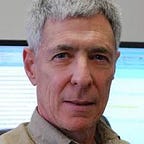My encounter with Andre Gregory
We tend to stay in our groove, navigating the crowds and the maze of the city, seamlessly avoiding contact. This is especially so in the subway, where we go to great lengths to avoid making eye contact.
One day in the early 1990s I took the risk of breaching the normal boundaries. I was taking the subway to work, and when the doors of downtown express opened at 72nd Street, I recognized the avant-guard director André Gregory, who got on and stood next to me holding on to the center pole and reading his New York Times.
Andre Gregory is best known for the movie My Dinner with André, in which he and his friend, the playwright Wally Shawn, sit and talk about the meaning of life for an hour-and-a-half over dinner in a restaurant. The conversation in which they try to understand each other is spell-binding. The movie came out in 1981 and was an art-house sensation. André Gregory is also known for his innovative theater productions going back to the 1960s.
So, for me, this was like standing next to Paul McCartney.
As the train began to slow down near 42nd Street, I folded my own paper preparing to get off, and, without premeditation, touched his arm, and said, “I have to tell you that my wife and I loved My Dinner with André. We’ve seen it several times.” We got to talking, and I mentioned that I had seen his production of Alice in Wonderland in a church in Greenwich Village twenty years earlier. He was interested to know how I liked it. Then he asked what I do, and I told him I did research on cancer. All this took place in the minute or two before the train entered the station.
He asked if my wife and I would like to come to see a rehearsal of Chekhov’s Uncle Vanya, which he was directing, called Vanya on 42nd Street. I said we would love to, and, as the doors were opening, he wrote down a phone number on a scrap of newspaper.
Later that day I called and he answered the phone and gave me a choice of dates and told me where to pick up the tickets. He then referred to my area of work and said that his wife had been battling cancer for the past two years and gave me the details. He wanted to know whether I had suggestions for what she should do. I said I was not a clinician, but it sounded like she was getting the best care possible.
So on a Saturday, we went to a rehearsal. The play was enormously powerful and moving. Julianne Moore, who was still unknown then, played the female lead. The venue was a huge, old cavernous theater on 42nd Street. We sat on stage with the other invited guests. Afterwards, we went up to André to say hello, and he introduced us to Wally Shawn. We told them how much we had enjoyed the play.
Somewhat later we read that his wife had died.
When we got home, my wife said that she would never have had the nerve to do what I had done. And I said that normally I wouldn’t have either. But the special thing about My Dinner with André is that you really feel you have come to know the two characters — that they are not playing roles in the ordinary sense. I just couldn’t resist the urge to avail myself of the opportunity to make contact.
The amazing thing about the city is that one is in close proximity to so many different lives, which remain opaque to us. Sometimes the invisible membrane separating us from the mass of humanity is breached — with unanticipated results.
